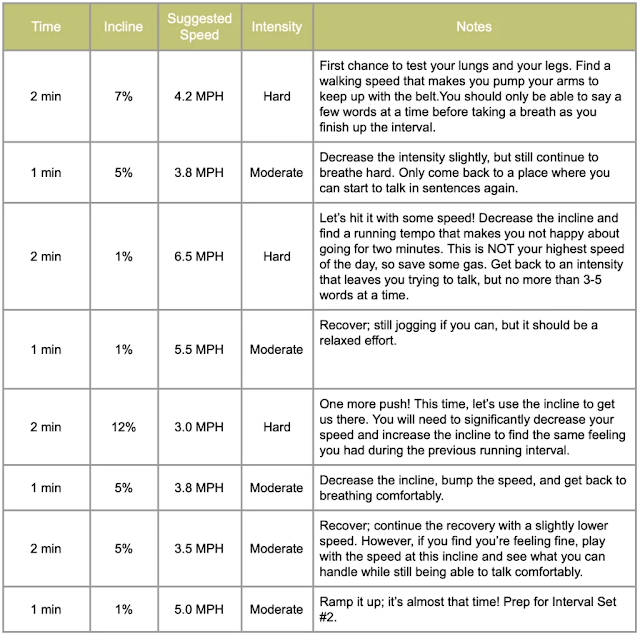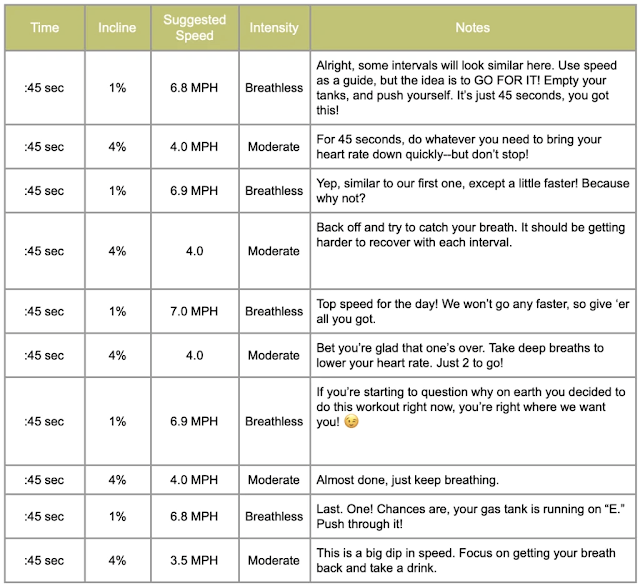You've definitely Googled best methods to burn calories or how to burn fat at some point—and there's no shame in that! Both are fair issues, and they can be a strong incentive for some individuals to exercise. If you're searching for a quick approach to burn a lot of calories or get in shape, HIIT workouts are usually the answer. "HIIT" is an abbreviation for high-intensity interval training, which involves alternating brief, intense bursts of work at your maximum heart rate with rest or lower-intensity exercise. If you're new to interval training, one of the most convenient methods to do a HIIT workout is on the treadmill—and for good reason. Interval training on the treadmill is not only a wonderful cardio exercise, but it also engages your muscles in the same manner that strength training does. Plus, unlike non-cardio HIIT exercises, treadmill workouts require almost no equipment (apart from the treadmill, of course), and they're simple enough to execute without a personal trainer, so you may do them at home or at the gym. Are you sold yet?
Treadmill
Doesn’t Have To Equal “Dreadmill”
The treadmill has
earned a terrible name, and some perceive it as nothing more than a
never-ending conveyor belt to nowhere—and we get why! The same pace, actions,
and surroundings might get monotonous, making the treadmill appear to be your
greatest foe when, in fact, it is your aerobic activities that are to blame.
Unless you're a member of the "Mile High Run Club," running—or brisk
walking—at the same speed for an extended period of time can get very boring,
fairly fast (regardless of which Netflix show you're watching). Not to add, if
burning calories and losing fat is your goal, running on the treadmill at a
constant speed is really less efficient. As a result, we devised this HIIT
treadmill routine…Allow us to clarify.
Benefits
of HIIT Treadmill Workouts
There are several research, information, and content available on why interval training produces the best outcomes, but we won't bore you with the science. Basically, here are a few reasons why we feel HIIT exercises are extremely effective:
They are effective. HIIT exercises are an excellent way to include fitness into a hectic schedule. Indeed, with the correct workout, you may burn the same number of calories in 30 minutes of HIIT as you would in an hour of steady training, giving you more time back in your day. Please, yes!
You'll burn fat both before and after your workout. It's true! High-intensity intervals need your body to use more oxygen in order to function properly, resulting in more calories expended. EPOC (excess post-exercise oxygen consumption), often known as the "afterburn" effect, allows you to continue burning calories as your body recovers from your increased metabolism. Isn't it cool?
They're not monotonous. While undertaking an HIIT exercise, it's
practically hard to read a book, surf through social media, or speak with a
buddy. You won't be bored since you'll be too busy punching buttons, checking
the timer, or trying to catch your breath. Furthermore, a HIIT exercise can
never be too easy; you can always increase the intensity. Keep in mind that you
receive out what you put in!
How
This 45-Minute Treadmill Workout Works
To perform this exercise, you don't need to have a personal running coach, run six-minute miles, or be a member of the "Mile High Run Club"; all you need is a treadmill under 500, less than an hour of time, and a commitment to make healthy happen!
This 45-minute programme will be divided into three parts: warm-up, workout, and cool-down. Doesn't it seem about right? The primary workout, on the other hand, will be separated into three distinct periods, which will then be broken down into one- or two-minute bursts of varying intensities—stay with us here.
Each burst will have a certain time and intensity; it is critical that you pay close attention to these columns. Both the incline and the speed are presented as suggestions, so you may adjust them as required. If you find yourself going over the specified intensity, reduce the pace or inclination a little. Below the level of fervour? Increase the tempo! Or perhaps you're unsure of the intensity at which you're working? The simplest approach to understand exercise intensity is to first determine your maximal heart rate, which you can obtain by subtracting your age from 220. This is the average number of times your heart should beat per minute during activity, thus the name maximal heart rate. You may then calculate your heart rate at different intensities using a heart-rate monitor or by counting how many times you feel your pulse in one minute.
To be more specific, we've broken out the intensity levels as they'll appear during the workout, as well as crucial bodily markers of each:
●
Easy: your breathing should remain reasonably normal, and you
should be able to hold a complete conversation at this rate.
●
Moderate: You should feel a modest rise in your breathing rate, but
nothing too dramatic. You should be able to talk in phrases but not sing more
than a few syllables without gasping for air.
●
Hard: At this point, you may notice an increase in your breathing
rate, and you may even begin to feel out of breath. This isn't quite
"full-on," but it's close. You should be able to talk a few words at
a time without running out of breath.
● Breathless: You guessed it! At this rate, you will feel "breathless," and you will need to slow down to collect your breath at the start of your recovery phase. You should be unable to speak aloud, which means you'll have to reserve those excellent phrases for another occasion.
Note: Always talk with a personal trainer or coach at your gym
first if you are uncomfortable, nervous, or unsure whether high-intensity
exercises are right for you. They will be delighted to assist!
The
Warm-Up
Before we begin
the workout, you must do this 5-minute interval warm-up to prepare your body
for the session ahead. Use this time to discover the treadmill's speed,
inclination, and emergency stop buttons, as well as to begin your blood moving
throughout your body (upper body included).
The Workout
You've made it to the big show! We'll complete three sets of shorter yet tougher intervals: Interval #1 is 12 minutes long, Interval #2 is 11 minutes long, and Interval #3 is 10 minutes long. Keep in mind that the purpose of calorie exercises is to burn as many calories as possible in the allotted period. That means you'll have to push yourself during high-intensity intervals while remaining focused during rest moments.
IMPORTANT: Start slowly if you're new to HIIT or treadmill training. You'll be pushing your body to its limits, so don't overdo it. If the indicated speeds or inclines do not work for you, make adjustments and focus on your intensity level, as previously said.
One more thing.
Don't forget to take deep breaths!
Interval Set
1
Interval Set
2
Interval Set
3
Walk It Off
You did a fantastic job! But wait... don't leap off that belt just yet. Lowering the pace and incline is an excellent strategy to gradually reduce your heart rate. Spend five minutes walking slowly and concentrating on your breathing. Examine your calories, distance, and heart rate. You have every right to be PROUD! That was a strenuous workout.
When you feel your pulse rate has stabilized, conclude your exercise with a full stretch of your muscles—don't forget about your upper body!











0 Comments